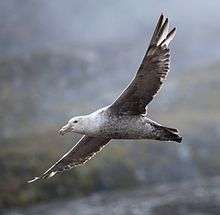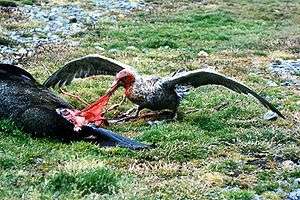Giant petrel
Giant petrels form a genus, Macronectes, from the family Procellariidae, which consists of two species. They are the largest birds of this family. Both species are restricted to the Southern Hemisphere, and though their distributions overlap significantly, with both species breeding on the Prince Edward Islands, Crozet Islands, Kerguelen Islands, Macquarie Island, and South Georgia, many southern giant petrels nest farther south, with colonies as far south as Antarctica. Giant petrels are extremely aggressive predators and scavengers, inspiring another common name, the stinker.[1] South Sea whalers used to call them gluttons.
| Giant petrel | |
|---|---|
_55.jpg) | |
| Southern giant petrel juvenile | |
| Scientific classification | |
| Kingdom: | Animalia |
| Phylum: | Chordata |
| Class: | Aves |
| Order: | Procellariiformes |
| Family: | Procellariidae |
| Genus: | Macronectes Richmond, 1905 |
| Species | |
|
Macronectes giganteus | |
Taxonomy
The giant petrels are two large seabirds from the genus Macronectes. Long considered to be conspecific (they were not established as separate species until 1966),[2] the two species, the southern giant petrel, M. giganteus, and northern giant petrel, M. halli, are considered with the two fulmars, Fulmarus, to form a distinct subgroup within the Procellariidae, and including the Antarctic petrel, Cape petrel, and snow petrel, they form a separate group from the rest of the family.[3]
| Image | Scientific name | Common Name | Distribution |
|---|---|---|---|
 | Macronectes giganteus | Southern giant petrel,Antarctic giant petrel, giant fulmar, stinker, and stinkpot | from Antarctica to the subtropics of Chile, Africa, and Australia |
 | Macronectes halli | Hall's giant petrel, Northern giant petrel | Southern Ocean north of the Antarctic Convergence Zone, and north through Chile, Argentina, South Africa, and half of Australia. |
Description
The southern giant petrel is slightly larger than the northern giant petrel, at 3 to 8 kg (6.6–17.6 lb), 180 to 210 cm (71–83 in) across the wings, and 86 to 100 cm (34–39 in) of body length.[1][4] The northern giant petrel is 3 to 5 kg (6.6–11.0 lb), 150 to 210 cm (59–83 in) across the wings and 80 to 95 cm (31–37 in) of body length.[5][6] They superficially resemble the albatross, and are the only procellarids that can equal them in size. They can be separated from the albatrosses by their bill; the two tube nostrils are joined together on the top of the bill, unlike on albatross, where they are separated and on the side of the bill. Petrels are also the only members of the family Procellariidae to have strong legs to walk on land.[1] They are also much darker and more mottled brown (except for the white morph southern, which are whiter than any albatross) and have a more hunch-backed look. The bills of Procellariiformes are also unique in that they are split into between seven and nine horny plates. The petrels have a hooked bill called the maxillary unguis which can hold slippery prey. They produce a stomach oil made up of wax esters and triglycerides which is stored in the proventriculus. This can be sprayed out of their mouths as a defence against predators and as a protein-rich food source for chicks and for the adults during their long flights.[7] Petrals have a salt gland situated above the nasal passage that helps to desalinate their bodies by excreting a high saline solution from their noses. [8]
The two species are difficult to tell from each other, possessing similar long, pale, orange bills and uniform, mottled grey plumage (except for around 15% of southern petrels, which are almost completely white). The billtip of M. halli is reddish-pink and that of M. giganteus is pale green, appearing slightly darker and lighter than the rest of the bill, respectively. The underside of older M. halli birds is paler and more uniform than M. giganteus, the latter showing a contrast between paler head and neck and darker belly.[9] Additionally, adults of M. halli typically appear pale-eyed, while adults of M. giganteus of the normal morph typically appear dark-eyed (occasionally flecked paler). Classic examples of northern giant are identifiable at some range. Young birds of both species are all dark and very hard to distinguish unless bill tip colour can be seen. Some relatively young northern giant petrels can appear to be paler on the head, suggesting southern giant, thus this species is harder to confirm.
Etymology
Macronectes comes from the Greek words makros meaning "long" and nēktēs meaning "swimmer". Also, petrel is derived from St. Peter and the story of his walking on water, as they appear to run on the water when they take off.[10]

Behaviour
Feeding
Petrels are highly opportunistic feeders. Unique among procellarids, they will feed both on land and at sea; in fact, they find most of their food near coastlines. On land, they feed on carrion,[1][9] and regularly scavenge the breeding colonies of penguins and seals. They will display their dominance over carcasses with a "sealmaster posture":[11] the head and the wings are held outstretched, the head pointing at the opponent and the wingtips pointing slightly back; the tail is raised to a vertical position. They are extremely aggressive and will kill other seabirds (usually penguin chicks, sick or injured adult penguins and the chicks of other seabirds), even those as large as an albatross, which they kill either by battering them to death or drowning.[12] At sea, they feed on krill, squid, and fish. They often follow fishing boats and other ships, in the hope of picking up offal and other waste.[9]

Reproduction
The southern giant petrel is more likely to form loose colonies than the northern, both species laying a single egg in a rough nest built about 50 cm (20 in) off the ground. The egg is incubated for about 60 days; once hatched the chick is brooded for 3 weeks. Chicks fledge after about 4 months, but do not achieve sexual maturity for another 6–7 years after fledging.[1]
Conservation
While both species are listed as near threatened in the 2008 IUCN Red List,[13][14] recent evidence suggests they are less threatened than previously believed, and the populations of both actually appear to have increased, at least locally. Consequently, they will be listed as least concern on the 2009 Red List.[9][15]
The southern giant petrel is listed as endangered on the Australian Environment Protection and Biodiversity Conservation Act 1999, while the northern giant petrel is listed on the same act as vulnerable.[16] Their conservation status also varies from state to state within Australia. For example:
- Both the southern and northern giant petrels are listed as threatened on the Victorian Flora and Fauna Guarantee Act (1988).[17] Under this act, Action Statements for the recovery and future management of these species have been prepared.[18]
- On the 2007 advisory list of threatened vertebrate fauna in Victoria, the southern giant petrel is listed as vulnerable, while the northern giant petrel is listed as near threatened.[19]
Gallery
 Giant petrel which has just killed a king penguin chick
Giant petrel which has just killed a king penguin chick Giant petrel flying above South Georgia Island
Giant petrel flying above South Georgia Island
References
- Maynard, B. J. (2003)
- Remsen Jr., J. V. (2008)
- Tree of Life (2008)
- "Archived copy". Archived from the original on 2008-07-20. Retrieved 2008-09-23.CS1 maint: archived copy as title (link)
- Environment, jurisdiction=Commonwealth of Australia; corporateName=Department of the. "Macronectes halli — Northern Giant Petrel". www.environment.gov.au. Retrieved 2017-07-27.
- Oiseaux.net. "Northern Giant-Petrel - Macronectes halli". www.oiseaux.net. Retrieved 2017-07-27.
- Double, M. C. (2003)
- Ehrlich, Paul R. (1988)
- BirdLife International (2009a)
- Gotch, A. F. (1995)
- de Bruyn, P. J. N. & Cooper, Æ J. (2005). "Who's the boss? Giant petrel arrival times and interspecific interactions at a seal carcass at sub-Antarctic Marion Island". Polar Biology. 28 (7): 571–573. doi:10.1007/s00300-005-0724-7.
- Cox, J. B. (1978). "Albatross Killed by Giant-petrel" (PDF). Emu. 78 (2): 94–95. doi:10.1071/MU9780094.
- BirdLife International (2008a)
- BirdLife International (2008b)
- BirdLife International (2009b)
- "EPBC Act List of Threatened Fauna". Australian government: Department of the Environment, Water, Heritage and the Arts. Retrieved 25 July 2009.
- Department of Sustainability and Environment, Victoria Archived July 18, 2005, at the Wayback Machine
- Department of Sustainability and Environment, Victoria Archived September 11, 2006, at the Wayback Machine
- Victorian Department of Sustainability and Environment (2007)
Further reading
- BirdLife International (2008a). "Macronectes giganteus". IUCN Red List of Threatened Species. 2008a. Retrieved 16 Mar 2009.CS1 maint: ref=harv (link)
- BirdLife International (2008b). "Macronectes halli". IUCN Red List of Threatened Species. 2008b. Retrieved 16 Mar 2009.CS1 maint: ref=harv (link)
- BirdLife International (2009a). "Southern Giant-petrel Macronectes giganteus - BirdLife Species Factsheet". Data Zone. Retrieved 16 Mar 2009.
- BirdLife International (2009b). "Northern Giant-petrel Macronectes halli - BirdLife Species Factsheet". Data Zone. Retrieved 9 June 2009.
- Brands, Sheila (14 Aug 2008). "Systema Naturae 2000 / Classification - Genus Macronectes -". Project: The Taxonomicon. Retrieved 16 Mar 2009.
- Brooke, M. (2004). "Procellariidae". Albatrosses And Petrels Across The World. Oxford, UK: Oxford University Press. ISBN 0-19-850125-0.
- Double, M. C. (2003). "Procellariiformes (Tubenosed Seabirds)". In Hutchins, Michael; Jackson, Jerome A.; Bock, Walter J.; Olendorf, Donna (eds.). Grzimek's Animal Life Encyclopedia. 8 Birds I Tinamous and Ratites to Hoatzins. Joseph E. Trumpey, Chief Scientific Illustrator (2nd ed.). Farmington Hills, MI: Gale Group. pp. 107–111. ISBN 0-7876-5784-0.
- Ehrlich, Paul R.; Dobkin, David, S.; Wheye, Darryl (1988). The Birders Handbook (First ed.). New York, NY: Simon & Schuster. pp. 29–31. ISBN 0-671-65989-8.
- Gotch, A. F. (1995) [1979]. "Albatrosses, Fulmars, Shearwaters, and Petrels". Latin Names Explained A Guide to the Scientific Classifications of Reptiles, Birds & Mammals. New York, NY: Facts on File. p. 191. ISBN 0-8160-3377-3.
- del Hoyo, Josep, Elliott, Andrew & Sargatal, Jordi (1992). Handbook of Birds of the World Vol 1. Barcelona:Lynx Edicions, ISBN 84-87334-10-5
- Maynard, B. J. (2003). "Shearwaters, petrels, and fulmars (Procellariidae)". In Hutchins, Michael; Jackson, Jerome A.; Bock, Walter J.; Olendorf, Donna (eds.). Grzimek's Animal Life Encyclopedia. 8 Birds I Tinamous and Ratites to Hoatzins. Joseph E. Trumpey, Chief Scientific Illustrator (2nd ed.). Farmington Hills, MI: Gale Group. pp. 123–133. ISBN 0-7876-5784-0.
- Remsen Jr., J. V.; et al. (7 Aug 2008). "A classification of the bird species of South America South American Classification Committee American Ornithologists' Union". South American Classification Committee. American Ornithologists' Union. Retrieved 9 Jul 2009.
- Tree of Life (27 Jun 2008). "Procellariidae. Shearwaters, Petrels". Tree of Life Web Project. Retrieved 18 Mar 2009.
- Victorian Department of Sustainability and Environment (2007). Advisory List of Threatened Vertebrate Fauna in Victoria - 2007. East Melbourne, Victoria: Department of Sustainability and Environment. p. 15. ISBN 978-1-74208-039-0.
External links
- Southern and Northern Giant Petrels - Species text in The Atlas of Southern African Birds.
- Video of George the Giant Petrel being released by New Zealand Department of Conservation